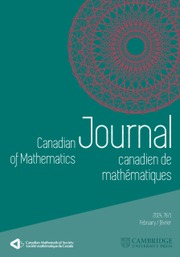No CrossRef data available.
Article contents
Thompson’s semigroup and the first Hochschild cohomology
Published online by Cambridge University Press: 07 March 2024
Abstract
In this paper, we apply the theory of algebraic cohomology to study the amenability of Thompson’s group  $\mathcal {F}$. We introduce the notion of unique factorization semigroup which contains Thompson’s semigroup
$\mathcal {F}$. We introduce the notion of unique factorization semigroup which contains Thompson’s semigroup  $\mathcal {S}$ and the free semigroup
$\mathcal {S}$ and the free semigroup  $\mathcal {F}_n$ on n (
$\mathcal {F}_n$ on n ( $\geq 2$) generators. Let
$\geq 2$) generators. Let  $\mathfrak {B}(\mathcal {S})$ and
$\mathfrak {B}(\mathcal {S})$ and  $\mathfrak {B}(\mathcal {F}_n)$ be the Banach algebras generated by the left regular representations of
$\mathfrak {B}(\mathcal {F}_n)$ be the Banach algebras generated by the left regular representations of  $\mathcal {S}$ and
$\mathcal {S}$ and  $\mathcal {F}_n$, respectively. We prove that all derivations on
$\mathcal {F}_n$, respectively. We prove that all derivations on  $\mathfrak {B}(\mathcal {S})$ and
$\mathfrak {B}(\mathcal {S})$ and  $\mathfrak {B}(\mathcal {F}_n)$ are automatically continuous, and every derivation on
$\mathfrak {B}(\mathcal {F}_n)$ are automatically continuous, and every derivation on  $\mathfrak {B}(\mathcal {S})$ is induced by a bounded linear operator in
$\mathfrak {B}(\mathcal {S})$ is induced by a bounded linear operator in  $\mathcal {L}(\mathcal {S})$, the weak-operator closed Banach algebra consisting of all bounded left convolution operators on
$\mathcal {L}(\mathcal {S})$, the weak-operator closed Banach algebra consisting of all bounded left convolution operators on  $l^2(\mathcal {S})$. Moreover, we prove that the first continuous Hochschild cohomology group of
$l^2(\mathcal {S})$. Moreover, we prove that the first continuous Hochschild cohomology group of  $\mathfrak {B}(\mathcal {S})$ with coefficients in
$\mathfrak {B}(\mathcal {S})$ with coefficients in  $\mathcal {L}(\mathcal {S})$ vanishes. These conclusions provide positive indications for the left amenability of Thompson’s semigroup.
$\mathcal {L}(\mathcal {S})$ vanishes. These conclusions provide positive indications for the left amenability of Thompson’s semigroup.
Information
- Type
- Article
- Information
- Copyright
- © The Author(s), 2024. Published by Cambridge University Press on behalf of Canadian Mathematical Society
Footnotes
This work was supported by Beijing Municipal Science & Technology Commission (Grant No. Z221100002722017) and by a grant from Beijing Institute of Mathematical Sciences and Applications. This research was also supported partly by the AMSS of Chinese Academy of Sciences and by YMSC of Tsinghua University.


